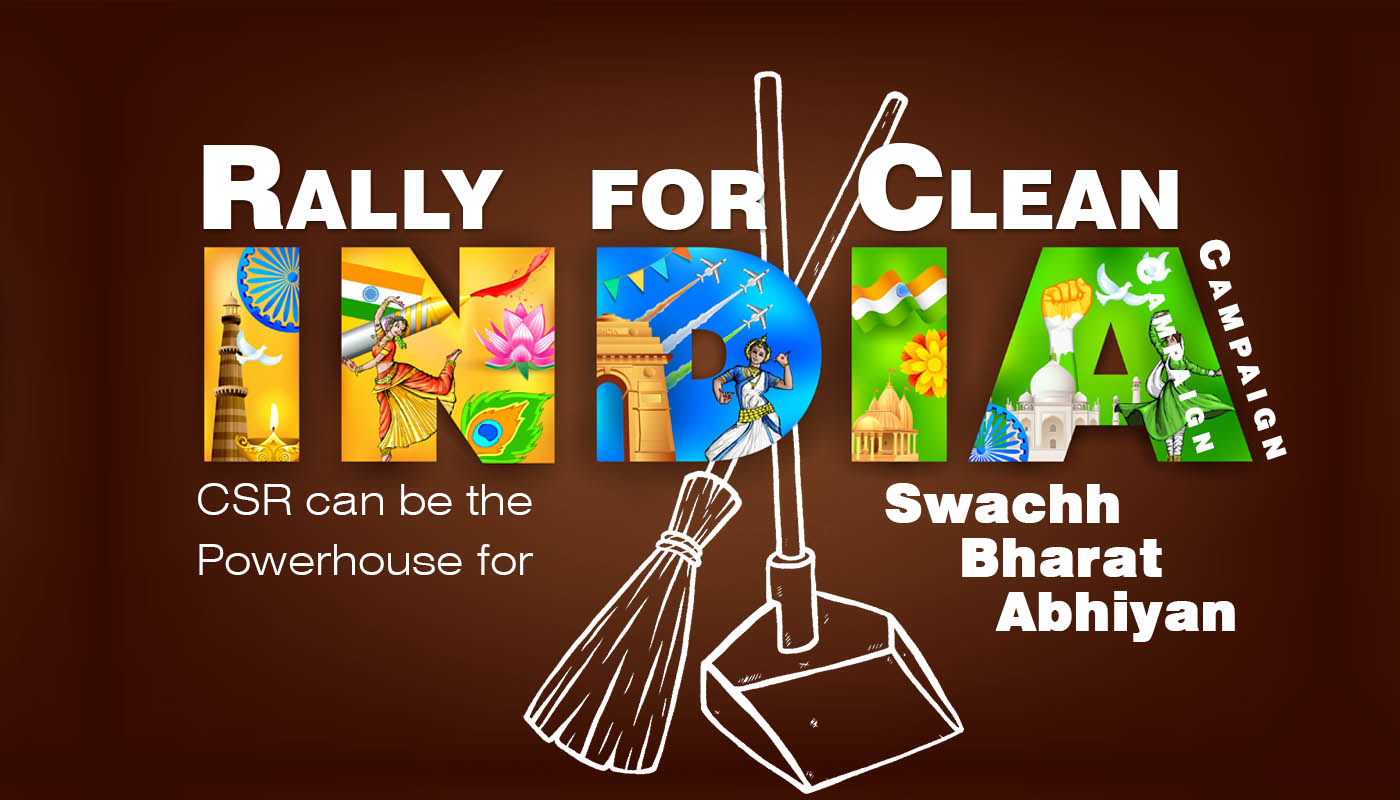As per estimates, poor hygiene and sanitation facilities cost india 600,000 lives annually due to diarrhoea and other such diseases. As per government data, India is a home to 450 million people who do not have access to toilets and defecate in the open. Not only this, lack of toilets also expose one third of country’s women to the risk of sexual assault.
Swachh bharat mission (SBM) or clean India mission was launched by prime minister of India, Narendra Modi on the birth anniversary of mahatma Gandhi on October 02, 2014, at Rajghat in New Delhi. This national campaign, initiated by the government of India, covers 4041 statutory towns across the country and aims to make the streets, roads and infrastructure clean by October 2, 2019, i.e. Mahatma Gandhi’s 150th birth.
NEED OF SWACHH BHARAT ABHIYAN
There is a dire need to implement swachh bharat abhiyan in totality and create a clean India. There are many obstacles and challenges in the path of Swachh Bharat Abhiyan. Problems such as open defecation and the dumping of garbage in public places still continue. When it rains, all the dirt, garbage and excreta get into the streams or ponds, polluting water sources. Otherwise too, people themselves throw waste materials into rivers or ponds in the absence of proper drainage system. Ponds and rivers are also used for bathing and washing purposes due to which huge quantity of dirt and pollutants get accumulated into the water bodies. Moreover, due to these activities, garbage, excreta, ashes of the dead, old clothes and solid materials are discharged into rivers and even sometimes dead bodies are also thrown into the rivers and water bodies. There are virtually no toilets in the slum settlements located near city-dwellings, or even if there is one, it generally doesn’t function properly. This calls for practising good hygiene in the true spirit of swachh bharat.
OBJECTIVES OF SWACHH BHARAT ABHIYAN
- To improve quality of life of people living in rural areas.
- Motivate people to maintain sanitation in rural areas to complete the vision of swachh bharat by 2019
- To motivate local working bodies (such as communities, Panchayati Raj institutions, etc).
- Develop advance environmental sanitation systems manageable by the community especially to focus on solid and liquid waste management in the rural areas.
- To promote ecologically safe and sustainable sanitation in the rural areas.
Need to save ganga river
The Ganga, the most sacred and worshipped river of the Hindus, is now one of the most polluted rivers of the country. Twenty five big cities located along its bank generated 1,340 sewage and over 95 per cent of the same entered the river without being treated prior to the Ganga Action Plan (GAP). Out of the total length of the river (2,525 km), from Gangotri to Gangasagar, about 600 km long stretch is highly polluted.
This pollution is due to the dumping of city garbage, industrial effluents, human and animal excreta, agricultural wastes, pesticides, burning of human bodies, community bathing and faulty social and religious practices. According to an estimate about 19,659 tons of polluted matter enters the river every year, of which, 55.4 % is contributed by Uttar Pradesh and 18.8% by West Bengal.
According to a study of the Central Board for Preservation and Control of water pollution, the long stretches of the Ganga near Kanpur and Varanasi are unsuitable for any beneficial human use. The water quality is generally good up to Bithoor, except near the city of Kannauj where polluted water from the Kali river and city sewage combine to exceed the assimilation capacity of the river.
At Haridwar, although the Ganga is considered to be the least polluted but the pollution starts from Rishikesh itself where industrial wastes from Bharat Heavy Electricals Limited (BHEL) have polluted the water. The disposal of industrial waste from the Indian Drug Production Ltd. (IDPL) adds to the problem. About 15 large sewage drains discharge 42 mid municipal sewage into the river.
Pollution gets accentuated sharply during kumbh ( every 12 years ) when up to 5 million devotees descend on the small town to bathe in the holy river. Most of the river water is drained out to irrigation canals at Haridwar which also reduces the pollution absorbing capacity of the river.
At Kanpur the story of Ganga becomes more pathetic. Here more than 200 million liters of wastewater is discharged daily into the river through 16 major drains. Chromium-rich from about 300 tanneries pose a serious problem. Besides tanneries, industrial wastes from cotton and woollen textile mills, jute mills, distilleries, sugar mills, paper and pulp mills and factories manufacturing synthetic chemicals like D.D.T., pesticides etc. are discharged into Ganga.
At Allahabad, the famous centre of Hindu pilgrimage, 13 drains discharge 112 mid of sewage into Ganga and its tributary Yamuna which contains 32.164kg of polluted material. Besides, the civic wastes from the city industrial area and phulpur fertilizer factory are also discharged into the river.
The annual Magli Mela and its 6- year and 12-year Kumbh Mela bring millions of devotee to the sacred confluence for holy bath many of which reside for a month in temporary Kumbha city. The community bathing not only degrades the water quality but the temporary camps produce large quantity of human excreta (about 250 tons/day on normal days and about 10,800 tons / day on main bathing days) which is dumped into the sand to be washed away during rainy season. The existing sewage treatment plants at Gaughat and Rajapur are not able to cope with the situation.
At Varanasi, the Ganga water becomes highly polluted where 71 large and small sewer drains discharge about 15 million gallons of effluents per day into the river, A problem peculiar to the city arises from the Hindu belief that the dead cremated here attain moksha (salvation). This results into cremation of about 40,000 dead bodies (50% brought from outside) at Manikarnika and Harishchandra burning ghats every year utilising about 15,000 tons of firewood and throwing out huge quantity of ash, unburnt wood and flesh into the river.
In Bihar, the capital city of Patna throws out 100 mid of waste water into the Ganga. The Bata shoe factory and Mcdowell Distillery at Mokama discharge 250,000 liters of toxic effluents/every day into Ganga which have adverse effect on the marine life. Fishes die within 5 hours at the site of outfall of drains of Mcdowell factory. The chemical wastes from the oil refinery of Barauni further worsens the situation.
At Kolkata more than 100 million gallons of urban industrial polluted water is discharged into the Hugli or Bhagirathi River. A 5-km stretch of the river between Bicholi Ghat and Garden Reach has become the worst polluted section.People often complain stomach trouble, kidney damage, skin diseases, and polio, typhoid, jaundice owing to the drinking of polluted water. About 1,500 human deaths were reported from the city due to the use of polluted water.
If people are not aware of their environment degradation and take responsibilities to save it, then all the efforts to save the environment are useless. The environment can be saved with proper cooperation and coordination of people which can make swachh bharat mission and clean Ganga mission possible. Every person should know that our environment is getting worse day by day and our rivers are drying. If we won’t perform our duties to save our mother Earth then the end of the Earth is not so far.
CSR CAN TAKE THESE INITIATIVES TO PROTECT ENVIRONMENT-
- To convert waste into electricity. There are many items around us that can generate heat, and surprisingly waste products are one of these. Heat generated from waste to create electric power is a great benefit to the earth because it can eliminate materials that ruin the ozone layer.
- To make common toilets in rural and urban areas.
- Artificial aeration / compressed air injection, in order to increase dissolved oxygen and biological activities to improve quality of Gangajal.
- Reclamation, restoration, conservation and maintenance of inland natural-riparian zones and wetlands on Ganga river.
- Removal of chir pine trees and replantation of banjo al and other native vegetation in lower to middle Himalayan belt.
- Effective and sustainable management of municipal solid waste in big cities at ‘special recycling zones’.
- Company should have their wastewater treatment facility, who either reuse the treated wastewater or discharge only after tertiary level water treatment.
- Increase green / forest cover-by organic farming, afforestation, agroforestry and natural permaculture.
- Stopping and covering landfill sights for pollution control and renewable generation.
- Maintaining cleanliness, law and order is the most important issue – which will require active participation and support from-central / state govt, National Ganga River Basin authority, local administration, municipalities, police, religious leaders, public, ngos, students, social group etc. We already have laws, guidelines and court rulings but the problem is local administration and municipalities are unable to enforce them due to- Limited resource, insufficient surveillance, no monitoring, lack of political will and very little active participation and involvement of public.
- It must be monitored and brought into force ,that, no one is littering in open public places, garbage is disposed in correct manner, no one immerses – half burned / partially burned bodies in Ganga (allow only electric cremation on ghats). No one is immersing dead animals in Ganga, no one is using river banks as open toilets (proper public toilets must be build), illegal river sand / stone mining is stopped, no unauthorized construction takes place in riparian zone, no one is discharging raw sewage in Ganga, washing clothes on river banks is stopped (build modern laundries- similar to Ahmedabad).
– During festivals and special occasions additional arrangements should be made for cleanliness.
jnicsr #jnicsrtimes #nikhilkumarsarojaz
www.jnicsr.com | www.jnicsrtimes.com







Leave a Reply